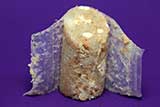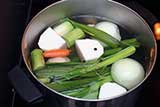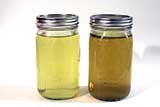Meats and Sausages
Recipe Guidelines
Vegetarian Sausage Recipes...
The recipes are strictly vegan. You can add, at your discretion, an egg or non-fat dry milk, and that will only improve the texture of the sausage. Gelatin is a wonderful binder, however, it is made from animal skins and bones. There are dozens of natural animal or collagen casings of different diameters, but they are of animal origin and are not included in recipes.
Modifying Meat Sausage Recipes
Vegetarian sausages can be made from countless combinations of fillers and spices. Take blood sausages for example. Except for 10-20% of blood and the occasional addition of meat, these sausages are made with buckwheat, barley, rice, rusk, or bread crumbs. Replace blood with flax emulsion and you will end up with a vegetarian sausage. Remove meat from Swedish potato sausage and replace it with textured vegetable protein, however, keep potatoes and the same spices. There are many known meat sausages that include filler material such as potatoes, bread crumbs, oats, buckwheat and barley groats, semolina and potato flour, rusk, cracker meal, and rice. Remove the meat component from the recipes, replace it with a suitable vegetarian equivalent, leave the original spices, and you will create a vegetarian version of a well-known recipe. Just make sure the ingredients don't fall apart when the sausage is sliced. Generally, it can be assumed that if a particular material for example semolina flour was added to meat sausage, it should make a good vegetarian sausage as well.
Cooking Sausages
The majority of meat sausages are cooked in water. This method produces the best results for vegetarian sausages as well. Cooking distributes ingredients better and is necessary to activate carrageenan, which gelatinizes at around 180° F (82° C). Potato starch gelatinizes at lower temperatures, nevertheless it also must be heated. It can be easily noticed that a sausage that feels soft after stuffing will firm up after only a few minutes of heat treatment. The grains and the flour are safe at room temperature only because they do not contain moisture. The moisture is introduced during mixing ingredients as they are usually precooked or soaked in water. This is an invitation to bacteria which they will definitely accept, and the spoilage begins. Cooking stuffed sausage kills bacteria and slows down spoilage. After stuffing the sausage may be placed in a refrigerator or frozen, however, they have to be cooked before serving which sets the additives and makes the sausage firmer. It is a good idea to immerse cooked sausages for 5 minutes in cold water. This step diminishes the shriveling of the casing. The freshly stuffed uncooked sausage has a very limited shelf life and its texture is poor, once it is cut it will keep losing moisture and its texture will improve.
Moisture Control
The manufacture of vegetarian sausages presents certain problems. The amount of salt or spices you can adjust, however, if the texture of the sausages is soft, it will remain soft. Fillers such as grains or beans absorb water during soaking and cooking, however, they don't stick together. They don't have "meat glue" that ground meat develops when mixed with salt. It is easy to cook grains in water until they become sticky and will not separate; however, when stuffed, the sausage will become very soft. We could draw out the excess of water by adding gums which will convert water into a gel. This, however, is of little help as the gel is soft as well. Gums work wonderfully with jellies and sauces which have a soft texture, but the sausages must be firmer. Make sure you don't add too much water to grains when cooking. If they are too soft, let them steam at low heat until more moisture evaporates.
Take note that materials such as bread crumbs, cracker meal, textured vegetable protein (TVP), and rusk are usually rehydrated 2-3 times their weight in water. Raisins, dry fruit, and flour will absorb water as well. If you want to use a significant amount of soft, moist material, for example, tofu, mix it with water-hungry fillers like TVP, bread crumbs, or cracker meal, but in their originaldry form. They will absorb water from tofu and the resulting mixture will be much firmer. Both soy protein concentrate and isolate will draw water as well. The advice is to add such ingredients that will draw out water and will act as a filler increasing the weight of the sausage. Potato flour is such a filler. If you end up with a soft stuffing mix, add some flour. Vital wheat gluten is an excellent thickener and filler; however, some people are allergic to it so we have tried to limit its use in recipes. You don't need tofu in every recipe. It will make all your sausages very similar; besides, all types of tofu are rather soft. However, when added at 10-20%, it makes a great show material. If you want to add more tofu, combine it with a dry filler that absorbs water, such as bread crumbs, TVP, dry raisins, cranberries or others. Those dry fillers will draw water out of tofu making the mixture much firmer. Once when the sausage is cut its texture will start to harden due to evaporation of moisture. The texture will be very firm in a day or two.
Any food cooked at home can be enriched with starch, flour, or gum, stuffed into a casing, and made into a sausage.
Oil
Oil presents another problem. It is needed to provide a better mouthfeel, unfortunately, it is a liquid and a slippery one. It is soft and finds its own path to flow which might result in oil pockets. Gums will not bind oil. When flour or starch is heated in oil, it will produce a thickening paste known as "roux," which then thickens soups, sauces or gravies. This is general cooking, which is technical, time-consuming and of no practical use in the sausage-making process. The best way to immobilize oil is to hide it inside an emulsion. A good example is mayonnaise; it looks appealing, tastes good, and includes plenty of oil which is hidden inside. Oil disappears inside of the emulsion, will not leak, yet still produces a good "mouthfeel." The emulsion hides and locks the oil away but it remains soft so you have to be careful about how much is added. If you mix oil directly with ingredients, limit the amount of oil to around 3%. Otherwise, the sausage might become oily. Up to 8% of oil can easily be added to emulsion, but it is recommended to use emulsion at 5-20%; otherwise, a soft sausage will be produced. A good idea is to mix oil with flour or soy protein which creates a paste.
Emulsions
The basic ratio for flaxseed emulsion is 1:2:2, 10 g flaxseed, 20 g oil, 20 g water, a total of 50 g. Most recipes call for 100 g emulsion. When added in the amount of 100 g to 1 kg of total material, 20 g flaxseed, 40 ml oil. 40 ml water, the emulsion provides 2% flaxseed, 4% oil and 4% of water.
Ground flaxseed mixed with 2-3 parts of water (no additional oil needed), creates a sticky paste which is a good substitute for an egg.
Soy protein emulsion (1:4:5) is very smooth without any visible particles; it has a very uniform color and a pleasant flavor. It is a good choice for sausages of uniform color such as hot dogs. When added at 100 g to 1 kg of the total material, 10 g soy protein: 40 g oil: 50 ml water, the emulsion provides 1% protein, 4% oil, and 5% water.
To sum it up both emulsions are very similar, the flaxseed emulsion introduces a little less water, is darker with minute particles of seeds visible and it has a certain individual flavor. It is somewhat sticky, which makes it particularly attractive for binding purposes and it is a great choice for grains. Additionally, flaxseed contributes to better digestion.
Spices
Go easy on salt, vegan sausage needs less salt than meat sausage. Be generous with spices, vegan sausage needs more spices than meat sausage.
Using Measuring Cylinder
You don't need to weigh water, vegetable stock, juice, or soy sauce. Each 1 ml of water weighs exactly 1 g. Let's say you need 50 g of water. Just fill the cylinder to the 50 ml mark and you have measured 50 g of water.
Oil weighs slightly less than an equivalent volume of water; for example, 1 tablespoon of water weighs 15 g and 1 tablespoon of oil weighs 14 g. There will be, however, a very minor error if we assume them to be equal and use the measuring cylinder.
- 1 oz = 28.35 g
- 1 oz fluid = 30 ml
- 1 ml of water = 1 g
- 1000 ml of water = 1 liter = 1000 g = 1 kg (2.2 lb)
- 1 Tbsp = 3 tsp
Replacing Water with Vegetable Stock
Best blood sausages are produced when barley or buckwheat groats are cooked in leftover meat stock that was obtained from boiling meats and bones. The groats absorb the meat stock flavor and a superior quality product is obtained. The same technique can be applied to vegetarian sausages if a vegetable stock is used instead of water. Vegetarian sausages incorporate plenty of filler material such as grains or beans. Emulsions need water, wheat gluten is made by mixing flour with water.
The flavor of the sausages will greatly improve if a vegetable stock is used instead of water. The stock can be prepared by boiling soup greens or dissolving commercially produced vegetable bouillon cubes in water. Some filler material such as rice, grains or groats can be boiled in a vegetable stock, other material like beans, dry rolls, or textured vegetable protein (TVP) can be soaked in stock.
It is doubtful that all of us will suddenly start cooking vegetable stock if only for the lack of space in the refrigerator or freezer. On the other hand, how hard is it to throw a bouillon cube into boiling water?
Eat Them Cold
Most sausages are eaten cold. Yes, we grill and boil some sausages, and although they may be consumed in the USA in large quantities, nevertheless the fact remains that most sausages in the world are eaten cold. Use your own judgment, you will probably heat up Potato Sausage, but eat cold Granola or Polenta with Cranberries.





















